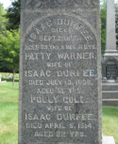
Isaac Durfee, son of Lemuel Durfee Sr. and Prudence Hathaway, was born on November 21, 1785 in Cambridge, Washington County, New York. He married Polly Cole, a sister of Abner Cole, in 1807 in Macedon, Wayne County, New York. She died in April 1814. In November 1814, Isaac married Patty Warner in Macedon. When she died in 1838, he married Anna Smith Hoag.
Isaac was a surveyor. He designated the middle of Stafford Road as the town line between Palmyra and Farmington.[1] Between 1810 and1820, Isaac served the community of Palmyra as an overseer of highways (1810, 1813–1814, 1818, 1822) and a commissioner of highways (1817, 1819–1820).
Isaac registered his mark for cattle in 1811: “A shallow’s fork in the end of the left ear and a half penny on the upper side of the right.”[2] Between 1812 and 1814, Isaac served as a private in the Bevier’s Battalion of the New York Militia and then as a private in the 3rd Regiment of US Volunteers. Between 1813 and 1814, Isaac was a sergeant in McIntyre’s Battalion in Lieutenant Colonel Gilbert Howell’s 39th New York Regiment of Light Infantry. On March 2, 1814, Isaac was appointed a lieutenant. On March 22, 1816, he was commissioned a captain in the 39th New York Infantry Regiment.
At the first town meeting of the town of Macedon held at the Lydia Porter house on February 11, 1823, Isaac was appointed a highway commissioner and an overseer of the poor. Between 1836 and 1837, he was a commissioner of highways in addition to his duties as superintendent of the poor. He also served as justice of the peace in Macedon.
On September 2, 1855, Isaac Durfee died at age sixty-three. At the time, he was residing with his brother Lemuel Jr. in a large cobblestone house on Dansen Road in Macedon, two miles north of Palmyra. Isaac died at 4 p.m. after an illness that lasted less than two weeks. Three weeks before his death, he was thrown from a buggy while driving home from Palmyra. While receiving no severe bruises, he was considerably shaken up and within a few days took to his bed. In his eulogy, it was said, “Mr. Durfee was a quiet, unostentatious man, never making any display of his wealth, but always ready and willing to help those deserving of his bounty.”[3] He was buried in the Palmyra City Cemetery. He willed his cobblestone house to his sons, Lemuel and Isaac Jr. His sons did not marry. They built a brick mansion on the property in the 1870s.[4]
[1] Porter, “A Study of the Origins of the LDS Church in New York and Pennsylvania,” p. 42.
[2] Old Palmyra Town Records.
[3] Durfee Scrapbook, no. 3, 1876–1883.
[4] “Stately Brick House built in 1870’s,” Newark NY Courier-Gazette, May 27, 1976.
